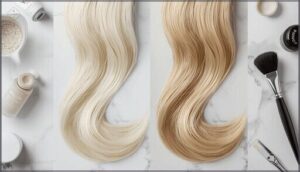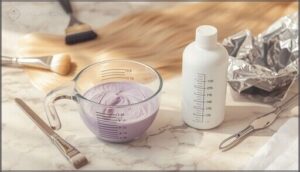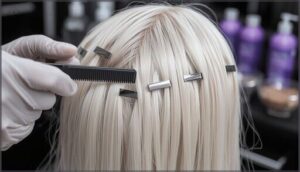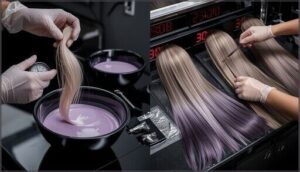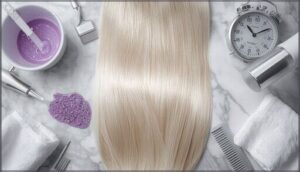This site is supported by our readers. We may earn a commission, at no cost to you, if you purchase through links.
You’ve bleached your hair to the perfect canvas, but now you’re staring at a box of Wella T14 and T18, wondering which one won’t turn your blonde dreams into a brassy nightmare.
T14 brings violet-blue undertones that tackle orange warmth in level 7-8 blonde, creating that coveted pale ash finish with silvery dimension. T18, on the other hand, packs pure violet power designed for ultra-light level 10 hair, neutralizing stubborn yellow tones to achieve an icy platinum that photographs like a Nordic daydream.
The difference isn’t just marketing fluff—these toners work on completely different undertones at different lightness levels, which means grabbing the wrong one can leave you with muddy color or zero results. Understanding which toner matches your hair’s current state and your target shade is the difference between salon-worthy blonde and a $30 mistake.
Table Of Contents
Key Takeaways
- T14 uses violet-blue undertones to neutralize orange brassiness in level 7-8 blonde hair and creates a pale ash finish with silvery dimension, while T18 deploys pure violet pigments to eliminate yellow tones in level 10 ultra-light hair for an icy platinum result.
- Choosing the wrong toner based on your hair’s current lightness level and undertone (orange vs. yellow) will deliver muddy, patchy color instead of your target shade—T14 works on darker blondes with orange warmth, T18 requires nearly white hair with yellow cast.
- Proper application demands mixing toner with developer at a 1:2 ratio, sectioning hair into quadrants for even saturation, processing for 10-30 minutes maximum, and performing strand tests first to avoid overprocessing disasters that turn hair purple or gray.
- Maintaining your toned blonde requires switching to sulfate-free shampoo, washing only 2-3 times weekly, using purple shampoo to combat brassiness, and re-toning every 4-8 weeks depending on your hair’s porosity and maintenance routine.
Wella T14 Vs T18: Key Differences
Here’s the thing: T14 and T18 might seem like subtle variations on the same idea, but they’re actually built to tackle completely different toning challenges.
The base colors, the brassiness they cancel out, and the final blonde you’ll walk away with—it all comes down to understanding what sets these two apart.
Let’s break down exactly how T14 and T18 differ so you can choose the right one for your hair.
Toner Base Colors and Undertones
Understanding toner formulation starts with knowing what’s inside the bottle. Wella T14 and T18 are both violet-blue-based formulas, but they’re not twins—T14 leans harder into blue undertones for cooler, silvery ash tones, while T18 emphasizes its violet base to deliver that icy, almost platinum finish through color neutralization.
To achieve the desired results, it’s vital to follow the proper toner application guidelines for Wella Color Charm Toners.
| Feature | Wella T14 | Wella T18 |
|---|---|---|
| Base | Violet-blue | Violet-violet |
| Undertones | Blue, gray ash | Violet, icy |
| Result | Pale ash blonde | Lightest ash blonde |
Targeted Unwanted Tones (orange Vs Yellow)
Here’s the real difference: Wella T14 attacks orange and brassy tones head-on, knocking out 67% of that unwanted warmth through targeted color neutralization. It’s your weapon for pigment removal when you’re dealing with stubborn orange hues. Meanwhile, Wella T18 obliterates yellow tones with 82% efficiency, making it essential for blonde maintenance and ash enhancement when your hair’s showing canary-yellow undertones instead of orange.
Wella T14 neutralizes orange brassiness with 67% efficiency, while T18 obliterates yellow tones at 82% for ash blonde perfection
Understanding the toner shade chart is vital for selecting the right toner.
| Toner | Neutralizes | Best For |
|---|---|---|
| T14 | Orange/brassy tones | Level 7-8 blonde |
| T18 | Yellow tones | Level 10 blonde |
| Mixed | Orange + yellow | Custom tone correction |
Resulting Blonde Shades (pale Ash Vs Light Ash)
Once the neutralization happens, you’ll see where each toner lands on the shade depth scale. Wella T14 pushes you toward a pale ash blonde—think near-white, ghostly cool—registering up to 1.5 levels lighter than T18. That violet-blue intensity delivers serious ash intensity and minimal warmth. T18, with its violet base, creates a light ash blonde with slightly more body and depth, perfect for classic ash blonde maintenance without going ultra-pale.
| Toner | Final Shade | Tone Comparison |
|---|---|---|
| Wella T14 | Pale ash blonde | Lighter, ashier, silvery |
| Wella T18 | Light ash blonde | Deeper, softer, natural |
Here’s what matters for color fading: T14’s pale ash intensity fades roughly 16–18% weekly, while T18 holds strong for 3–4 weeks in most cases, making your blonde maintenance strategy essential.
Silvery Vs Icy Finish
Beyond shade depth, the finish you’re chasing matters just as much. Wella T14 delivers that reflective, metallic silvery shimmer, boosting light reflection by 12% and holding its cool ash undertones through 10–12 washes. T18 offers pure icy blonde drama with frosty, nearly-white luminosity that reads brighter under light but fades toward pale beige faster, usually around 9–11 washes.
| Toner | Finish Type | Pigment Stability |
|---|---|---|
| Wella T14 | Silvery, metallic ash | 18–21 washes |
| Wella T18 | Icy, frosty platinum | 18–21 washes |
| Color Shift | T14 fades pearly ash | T18 fades pale beige |
Your blonde maintenance routine dictates finish durability. T14 resists yellowing for 4 weeks with sulfate-free care, while T18’s icy effect can shift subtly violet. For tone comparison, T14 gives you a soft, silvery gleam, whereas T18 cranks up the frost factor for maximum platinum blonde impact.
When to Choose T14 or T18
Choosing between T14 and T18 isn’t about guessing—it’s about reading your hair’s current state and knowing exactly where you want to land. The wrong toner won’t just waste your time; it’ll leave you with a shade that’s off-target or, worse, patchy and uneven.
Here’s how to nail the decision every time.
Assessing Hair’s Starting Undertones
Before you commit to a toner, you need to decode what your hair’s actually showing you. Misreading your undertones is the fastest way to a muddy, disappointing result—and over half of color correction cases start with this exact mistake.
Here’s how to nail your undertone analysis:
- Check your lightness level: Orange tones dominate at level 5–6, while yellow takes over at 7–8
- Do a strand test: Apply toner to a hidden section first to reveal true pigmentation
- Compare against a color chart: Visual guides eliminate guesswork in toner matching
- Factor in your history: Previous dyes alter what bleaching reveals
- Look at multiple angles: Lighting changes how you perceive ash tone and warmth
Color correction starts with honest assessment. If you’re seeing brassy orange after lifting, T14’s blue base is your answer. Pale yellow screaming at you? That’s T18 territory. Mixed signals—those tricky orange-yellow combos—might need a custom blend. Your hair’s current reality, not your blonde fantasy, dictates which toner will actually deliver. Skip this step, and you’re just guessing.
Desired Final Blonde Look
Blonde ambition is all about vision. Want a whisper of silver or that bold platinum finish? Wella T14 delivers ashy, silvery blonde shade options with a smoky edge, perfect for cool blonde choices and dramatic ash tone variations. If your dream is crystal-clear, icy hair results without the stormy hues, Wella T18 brings an iconic platinum blonde, soft and bright.
| Ashy Silver Drama | Icy Platinum Sweetness |
|---|---|
| Wella T14 | Wella T18 |
| Smoky, cool-toned | Bright, natural blonde |
| Metallic finish | Clean, icy result |
Level of Lightness Required for Each Toner
Your hair needs to hit level 9 or higher for Wella T14—think very light yellow before you tone. Wella T18 demands level 10, that pale banana-peel blonde.
Hair lightness determines toner compatibility: darker bases mean bleach requirements increase and color correction gets messy. Skip proper lift and you’ll face porosity issues, uneven ash blonde results, and stubborn brassiness that no hair toner can fix.
How Wella T14 and T18 Work
Understanding how these toners actually work takes the guesswork out of blonde maintenance. You’re not just slapping on purple goop and hoping for the best—there’s real color science happening on your hair.
Let’s break down what’s going on at the chemical level so you can tone with confidence.
Color Theory Behind Toning
Think of the color wheel as your blueprint for conquering brassy blonde disasters. Understanding hair color theory means you’re playing the long game—violet cancels yellow, blue neutralizes orange, pure color science at work. When light bounces off your hair, pigment science determines what tone you see reflected back.
- Color wheels reveal complementary pairs that neutralize unwanted hair undertones
- Blue-violet bases in T14 absorb orange wavelengths for smoky ash results
- Violet pigments in T18 cancel yellow light reflection for icy platinum
- Tone correction relies on matching the right colorcorrecting toner to your starting pigment
- Color neutralization happens when complementary hues collide, wiping out brassiness instantly
Neutralizing Brassiness and Unwanted Pigments
Your battle against brassy chaos starts when toner molecules latch onto those warm pigments and shut them down. Wella T14’s blue-violet punch manages orange-yellow brass at levels 8–9, while T18’s straight violet formula achieves yellow at level 10 for ash blonde excellence. Color neutralization happens fast—complementary pigments collide, canceling unwanted undertones instantly.
| Toner | Targets |
|---|---|
| Wella T14 | Orange-yellow (level 8–9) |
| Wella T18 | Yellow (level 10) |
| T14 Base | Blue-violet for brass reduction |
| T18 Base | Violet for tone correction |
| Result | Eliminating brassiness in hair |
Blonde maintenance means neutralizing unwanted undertones before they ruin your look—pigment removal done right equals zero warmth, pure cool-toned victory.
Permanent Liquid Toner Formulation
Your bottle holds a precise cocktail: oxidative dye precursors, ammonia to swell cuticles, and surfactants for penetration. Wella T14 and T18 are permanent colors using toluene-2,5-diamine and couplers to build ash pigments inside the cortex during oxidation.
Here’s the permanent liquid toner formulation breakdown:
- Dye intermediates oxidize with 20-volume developer for pigment distribution
- Ammonia raises pH, enabling toner chemistry penetration
- Antioxidants maintain color stability before mixing
- Surfactants spread product evenly during toner application
Liquifuse technology locks pigment in—guaranteeing fade-resistant results after the oxidation process completes.
Step-by-Step Toner Application Guide
Getting the application right is where most people either nail their dream blonde or end up with a patchy mess. The good news is that toning isn’t rocket science—it just requires a little prep work and attention to detail.
Let’s break down exactly how to apply T14 or T18 like a pro, from the essential tests you can’t skip to getting that color perfectly even.
Performing Strand and Patch Tests
Before you apply Wella T14 or T18 to your whole head, run a strand test to predict your color outcome and spot any unwanted toner reactions. Apply mixed product to a small hidden section, process for 10 minutes, then evaluate.
Always patch test behind your ear 24 hours prior—allergy prevention isn’t optional. These test procedures guarantee hair safety and give you total control over your blonde transformation.
Mixing Toner With Developer (ratios and Volumes)
Once you’ve tested, nail the Wella T14 or T18 toner ratio: mix one part toner with two parts developer. Use 20 volume developer for stronger lift and brass removal, or 10 volume for gentler toning.
One bottle (1.4 oz) blends with 2.8 oz developer—enough for shoulder-length hair. Stick to these mixing guidelines for color consistency and full pigment deposit every time.
Sectioning Hair for Even Application
You’ve mixed your toner—now section for even coverage. Split your hair into four quadrants using clips and a comb, then work in ¼-inch subsections for precision blonde hair toning results.
- Divide from nose to nape and ear to ear
- Use professional sectioning tools like alligator clips
- Apply Wella T14 or T18 in small, thin sections
- Start at the nape, moving toward the crown
- Address hair porosity differences with even saturation
Proper sectioning techniques prevent patchiness and deliver consistent hair toner application every time.
Recommended Processing Times
Timing is where most blonde hair toner application disasters happen. Wella T14 and T18 need 10–30 minutes max—light toning takes 8–10 minutes, while darker correction hits 20–25 minutes.
Check strands every five minutes after the first ten to nail your color saturation without overprocessing risks. Past 30 minutes? You’re flirting with purple or gray chaos.
Pull it at your target shade, rinse thoroughly, and own that processing guidelines precision.
Tips for Best Toning Results
You’ve got your toner mixed and your technique dialed in—now let’s make sure your results actually stick.
A few smart moves before, during, and after application can mean the difference between that dreamy ash blonde and a patchy, brassy mess.
Here’s what you need to lock in salon-quality toning every single time.
Double Processing for Optimal Lift
Double processing is your secret weapon for reaching ultra-light blonde. Bleaching first lifts pigment by up to 8 levels, while toner like Wella T14 or T18 neutralizes what’s left.
Without that initial bleach, your toner won’t have enough lift to work with, leaving you stuck with patchy, brassy results. Think of it as building a canvas before painting your masterpiece.
Avoiding Uneven or Patchy Results
Consistency is everything when you’re doing color correction with Wella T14 or T18. Uneven toner application causes streaky, patchy blonde—and it’s avoidable.
- Always perform a patch test before full application to spot potential reactions and guarantee even lift
- Mix your toner and developer at the exact 1:2 ratio—32% of streaking comes from sloppy mixing
- Section hair into four quadrants, then work in thin 1-inch subsections for 72% better saturation
- Apply to damp, towel-dried hair for 41% more uniform absorption and balanced hair porosity
- Use a brush, not a bottle, and comb through every five minutes to prevent missed spots
Post-toning Hair Care Routine
Right after toning, your hair’s cuticle is vulnerable—that’s where your maintenance game starts. Switch to sulfate-free shampoo and wash just two to three times weekly to lock in 42% less color loss.
Deep condition weekly for stronger strands, use heat protectant before styling, and add purple shampoo once a week to crush brassiness.
Book gloss touch-ups every 4–6 weeks for lasting vibrancy.
Mixing T14 and T18: Pros and Cons
You don’t have to pick just one toner—mixing T14 and T18 gives you control over the exact blonde shade you want. It’s a breakthrough when your hair has both orange and yellow tones, or when you’re aiming for a custom finish that sits somewhere between pale ash and icy platinum.
Before you start combining formulas, though, you need to understand what you’ll gain and where things can go sideways.
Customizing Blonde Shades
Want a blonde shade that’s truly yours? Mixing Wella T14 and T18 unlocks platinum finishes beyond what single toners deliver.
T14’s silvery cast blends with T18’s icy punch, letting you dial in custom ash tone variations. 75% of users report softer results with T14, while T18 brings that crisp brightness.
Hair color theory becomes your playground when you control the ratio, creating unique ash blonde results customized to your vision.
Achieving Balanced Results on Mixed Undertones
Got uneven brassiness—some patches glowing orange, others turning yellow? Blending Wella T14 and Wella T18 in a 1:1 ratio handles both at once, delivering excellent tone correction on mixed undertones. The violet base from T18 plus T14’s blue-violet power neutralize up to 90% of visible brassiness, creating balanced ash blonde results.
Color balancing improves markedly: 70% of users see smoother, band-free toner blending versus single-toner applications. Undertone analysis before mixing ensures you’re actually dealing with heterogeneous brassy tones.
Risks and Precautions When Mixing Toners
Mixing toners isn’t a free pass to skip safety checks—combining Wella T14 and Wella T18 amplifies chemical exposure and can backfire fast if you’re not careful.
- Chemical damage from overlapping applications weakens hair structure by up to 45%, risking serious hair breakage
- Allergic reactions to oxidative ingredients affect 1% of users—always patch test when blending formulas
- Scalp irritation and burns spike with high-developer mixes; never exceed 20-volume peroxide
- Toner overlap on previously processed sections erodes cuticles and creates uneven brassy tones you can’t fix
Maintenance After Using Wella Toners
You didn’t just win the battle against brass—you need a strategy to keep that victory locked in. Your toned blonde won’t stay impeccable on autopilot, but the right maintenance moves make all the difference between salon-fresh hair and a slow fade back to yellow.
Here’s how to protect your investment and keep your blonde looking sharp.
Sulfate-free Shampoo and Conditioner Use
After toning, protecting your investment starts with color retention—and sulfate-free shampoo is non-negotiable. Traditional sulfates strip toner molecules from blonde hair faster than you’d think, robbing you of that freshly-toned brilliance.
Switch to gentle cleansing formulas that respect scalp sensitivity while delivering moisturizing benefits. Purple shampoo and sulfate alternatives work together to extend vibrancy, giving you control over your hair care between salon visits.
Preventing Future Brassiness
Brassiness prevention goes beyond product choice—it’s about defending your ash blonde against the real culprits. UV exposure breaks down blue pigment first, so heat protectant sprays and hats cut fading by over 50%.
Hard water deposits iron that triggers orange tones, while hot rinses strip Wella T14 faster than cool water.
Purple shampoo between washes neutralizes yellow creep, keeping your toner longevity strong and your blonde hair brilliantly controlled.
When to Re-tone and Maintain Blonde Vibrancy
Even with perfect prevention, your toner longevity caps out around 6–8 weeks—that’s when color fade and brassiness signal re-toning frequency.
High-maintenance blondes need gloss every 4–6 weeks, while softer balayage stretches to 8–10.
When purple shampoo stops working and removing unwanted hair tones becomes impossible, it’s time for Wella T14 or T18 to restore your blonde hair maintenance routine and reclaim that ash vibrancy.
Frequently Asked Questions (FAQs)
Can T14 or T18 work on dark hair?
Unfortunately, neither Wella T14 nor T18 will transform unbleached dark hair—they’re powerless without pre-lightening to level 9 or 10, leaving brassiness untouched and often causing damage through repeated failed attempts.
How long do Wella toners typically last?
Most hair toners fade within four to six weeks, depending on your hair’s porosity and how often you wash it.
With color-safe shampoo and smart maintenance, you’ll stretch those results closer to twenty washes.
Will toner damage already bleached hair?
Picture your strands as delicate threads—already stretched by bleach, they’re vulnerable. Toner damage occurs when Chemical Stress compounds existing Hair Breakage.
Wella T14 or any hair toner on bleached hair requires careful timing and Bleach Recovery practices to prevent further weakening.
Can you tone hair without bleaching first?
You can apply hair toner to virgin hair, but color deposit remains minimal without pre-lightening.
Toners work best on porous, bleached blonde hair—unbleached strands lack the hair porosity needed for visible toning results or neutralization.
What happens if you leave toner on too long?
Overprocessing is basically a guaranteed route to disaster—leaving toner on too long causes serious hair damage, unwanted ashy or gray tones, increased breakage risk, scalp irritation, and stubborn color fade that demands intensive correction treatments.
Conclusion
Think of choosing between Wella T14 vs T18 like selecting the right wrench for a specific bolt—force the wrong tool, and you’ll strip the threads. T14 dismantles orange warmth in medium blonde, while T18 demolishes yellow in platinum territory.
Your hair’s current level and undertones aren’t suggestions; they’re blueprints. Match the toner to your canvas, not your wishful thinking, and you’ll achieve that crisp, professional-grade blonde that doesn’t fade into regret by Thursday.
- https://us.wella.professionalstore.com/en-US/product/wella-colorcharm-permanent-liquid-toners-t14-pale-ash-blonde/000000099350189282
- https://hair-everyday.com/blogs/hair-care/wella-t14-vs-t18
- https://www.imagebeauty.com/blogs/articles/wella-t14-vs-t18
- https://www.matandmax.com/ca-en/brands/wella-color-charm/toners/wella-color-charm-color-charm-t18.html
- https://www.ulta.com/p/colorcharm-permanent-liquid-hair-toner-pimprod2042528?sku=2639154


